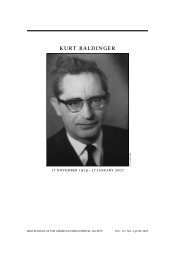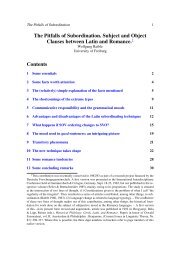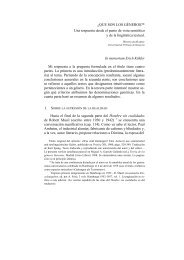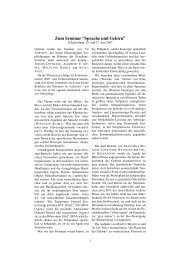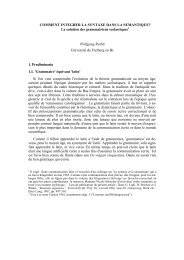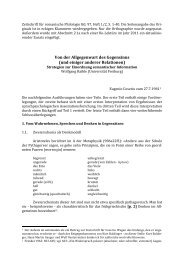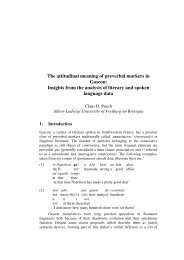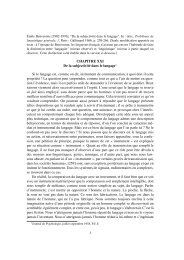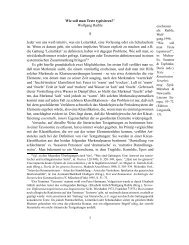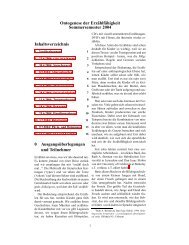A Summary of Role and Reference Grammar
A Summary of Role and Reference Grammar
A Summary of Role and Reference Grammar
Create successful ePaper yourself
Turn your PDF publications into a flip-book with our unique Google optimized e-Paper software.
-muta-y- (BECOME open´ (x)), in which -y- cancels the ‘...CAUSE’ part <strong>of</strong> the LS, <strong>and</strong> -muta-ymaa<br />
(open´ (x)), in which -maa cancels the BECOME part <strong>of</strong> the LS. Examination <strong>of</strong> the verbal<br />
systems <strong>of</strong> a number <strong>of</strong> languages had led to the conclusion that this set <strong>of</strong> distinctions is one <strong>of</strong><br />
the fundamental organizing principles <strong>of</strong> verbal systems in human language.<br />
The semantic representation <strong>of</strong> a clause contains information about operators like illocutionary<br />
force <strong>and</strong> tense in addition to the LS <strong>of</strong> the predicating element. A simple example is given<br />
in (11).<br />
(11) a. Are the children playing?<br />
b. 〈IF INT 〈TNS PRES 〈ASP PROG 〈[do´ (children, [play´ (children)])]〉〉〉〉<br />
Semantic roles<br />
The RRG theory <strong>of</strong> semantic roles is rather different from that <strong>of</strong> other theories, in that it<br />
posits two types <strong>of</strong> semantic roles. The first are specific thematic relations, the traditional (since<br />
Fillmore 1968 <strong>and</strong> Gruber 1965) notions <strong>of</strong> agent, theme, patient, experiencer, etc. The second<br />
are generalized semantic roles called ‘semantic macroroles’; they were introduced in Van Valin<br />
(1977) <strong>and</strong> have no exact analog in other theories, although Jackend<strong>of</strong>f’s ‘action tier’ <strong>and</strong><br />
Dowty’s proto-roles bear some resemblance. (See Van Valin (1999) for a comparison <strong>of</strong> different<br />
theories <strong>of</strong> generalized semantic roles.) Following the ideas <strong>of</strong> Gruber (1965) <strong>and</strong> Jackend<strong>of</strong>f<br />
(1976), RRG defines thematic relations in terms <strong>of</strong> argument positions in LSs such as those in<br />
(7)-(8). All thematic relations are defined in terms <strong>of</strong> argument positions in state <strong>and</strong> activity<br />
LSs; all other LS types are composed <strong>of</strong> them plus elements like BECOME, INGR <strong>and</strong> CAUSE.<br />
The thematic relations posited in RRG are given in Table 2.<br />
I. State verbs<br />
A. Single argument<br />
1. State or condition broken´ (x) x = patient<br />
2. Existence exist´ (x) x = entity<br />
B. Two arguments<br />
1. Pure location be-LOC´ (x, y) x = location, y = theme<br />
2. Perception hear´ (x, y) x = perceiver, y = stimulus<br />
3. Cognition know´ (x, y) x = cognizer, y = content<br />
4. Desire want´ (x, y) x = wanter, y = desire<br />
5. Propositional attitude consider´ (x, y) x = judger, y = judgment<br />
6. Possession have´ (x, y) x = possessor, y = possessed<br />
7. Internal experience feel´ (x, y) x = experiencer, y = sensation<br />
8. Emotion love´ (x, y) x = emoter, y = target<br />
9. Attributive be´ (x, [pred´]) x = attributant, y = attribute<br />
10. Identificational be´ (x, [pred´]) x = identified, y = identity<br />
11. Specificational be´ (x, y) x = variable, y = value<br />
12. Equational equate´ (x, y) x, y = referent<br />
13



